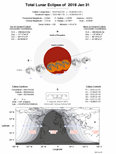![]()
- - text and links as of last publication - -
That first lunar eclipse for that year, and the first major astronomical event in 2018 is the total lunar eclipse of January 31st, 2018. A total lunar eclipse if a fine show worth the observation, with Moon progressively occulted and darkened by Earth's 'umbra,' giving a deep sense of the astronomical scales of the Universe and the large events which may occur there. for more about Moon eclipses, theoretically, see our tutorial: Moon Eclipses. The total lunar eclipse of January 31st, 2018 belongs to Saros 124 and is number 49 of 73 eclipses in the series as all eclipses in that series occur at Moon’s ascending node. That eclipse further is occurring 1.2 days after the Moon's perigee, which means the Moon will be relatively large as the Moon will be seen in constellation Cancer, the Crab. As the Full Moon of January 31st coincidates with the Moon at the perigee, the total lunar eclipse of January 31st, 2018 will constitute a 'supermoon' eclipse and like the second Full Moon in a same month, it will be a 'blue supermoon' eclipse
As the Moon during that total eclipse will transit deep enough into the Earth's umbra, the eclipse, at greatest, will be dark enough. The entirety of the total eclipse will be seen from China and central Siberia up to Alaska -- which means the eclipse will concern almost all of the Pacific area, the southeast of it excepted. Areas either part of that either will have the eclipse by moonrise, like from the western parts of China to northern and eastern Europe and to eastern Africa too, or the eclipse by moonset, like for the most part of North America, the central America, and the northwest of South America. No eclipse is see for the most of South America, the non-eastern part of Africa and western Europe
The eclipse's main data are the following (data as of November 2017, EclipseWise.com). for more about how to observe a lunar eclipse, see our tutorial 'Observing a Moon Eclipse':
- umbral magnitude (fraction of Moon's diameter immersed in the umbra at greatest): 1.31547
- greatest eclipse: 13:29:51.4 UT
- eclipse duration (penumbral): 05h17m19.4s
- eclipse duration (umbral): 03h22m45.9s
- eclipse duration (total): 01h16m04.6s
- eclipse contacts (in UT): P1 (penumbral eclipse begins) at 10:51:12.9, U1 (umbral eclipse begins) at 11:48:27.7, U2 (total eclipse begins) at 12:51:48.5, U3 (total eclipse ends) at 14:07:53.1, U4 (umbral eclipse ends) at 15:11:13.6, P4 (penumbral eclipse begins) at 16:08:32.3
 | see a .PDF map for the total lunar eclipse of January 31st, 2018 (path of the Moon within the Earth's umbra and map of the visibility of the eclipse worldwide). map courtesy EclipseWise.com |
. for more about this eclipse and for more about solar and lunar eclipses generally, you may see at the Internet, with Fred Espenak a reference in the domain
Website Manager: G. Guichard, site 'Amateur Astronomy,' http://stars5.6te.net. Page Editor: G. Guichard. last edited: 1/1/2019. contact us at geguicha@outlook.com